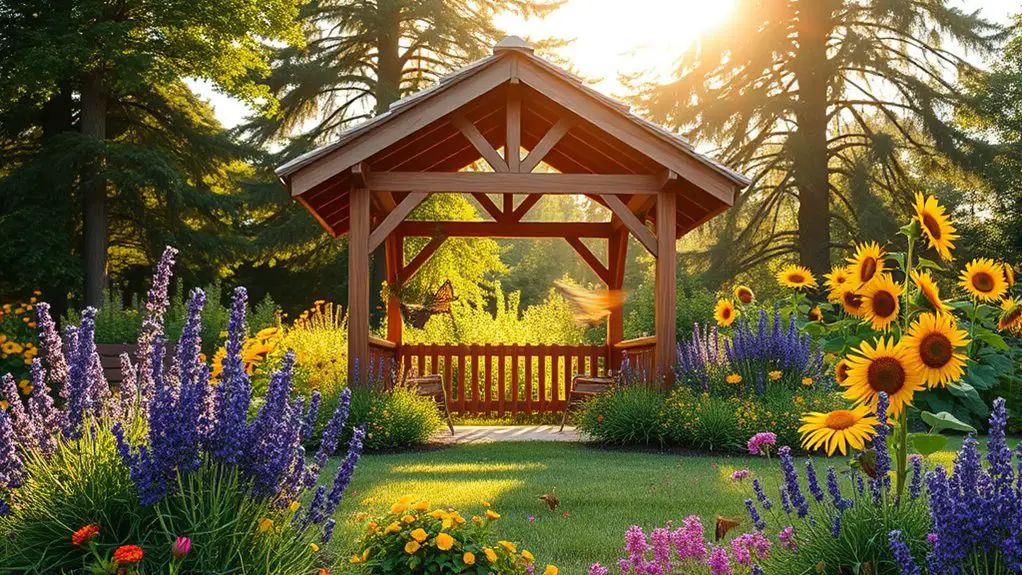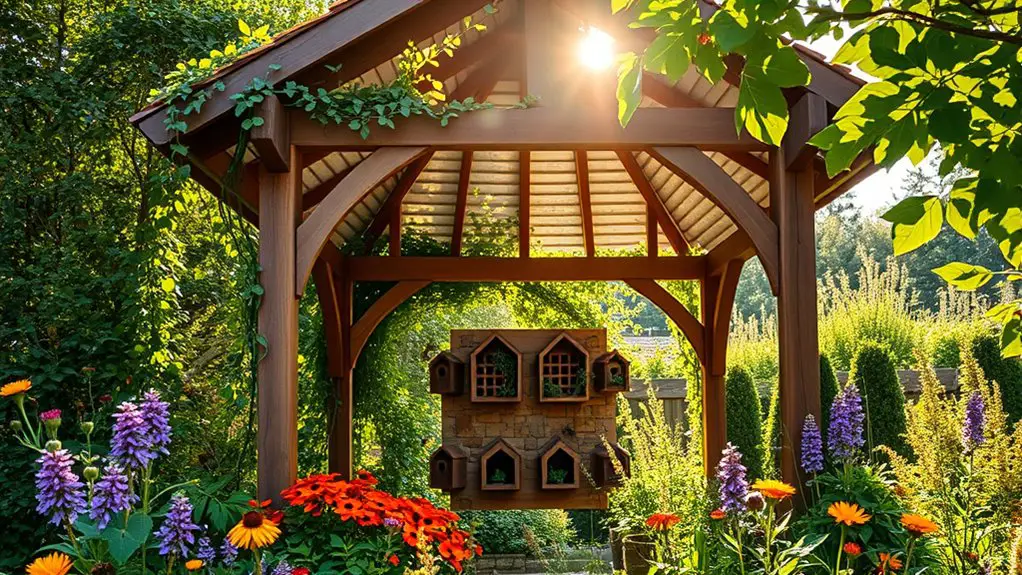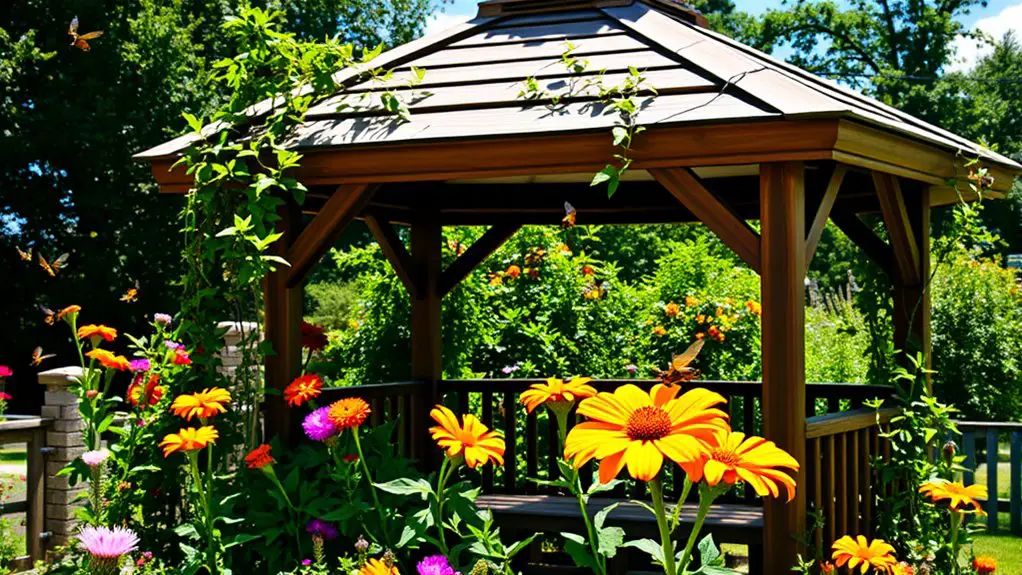Using a gazebo to encourage bees and pollinators can transform your garden into a lively habitat. Choose a location near flowering plants for easy access to food, and design it with sunlight in mind to attract visitors. Incorporate native plants and colorful blooms, along with nesting areas and water sources like birdbaths. By creating a diverse ecosystem, you enhance beauty and support pollinator health. Discover more ways to effectively engage and sustain these essential insects as you continue your gardening journey.
Choosing the Right Location for Your Gazebo

When you’re deciding where to place your gazebo, have you considered how its location can impact local wildlife, especially bees and other pollinators? The right gazebo orientation can create a welcoming space for these crucial creatures, enhancing your garden’s ecosystem. Positioning your gazebo near flowering plants guarantees pollinators have easy access to food sources, promoting their health and activity.
Think about landscape compatibility, too. A gazebo nestled among native plants not only offers shade and beauty but also fosters a natural habitat for bees. Avoid placing it in isolation; instead, integrate it into your garden’s flow. This way, you create a vibrant space that attracts pollinators while enjoying the freedom of outdoor living.
Additionally, consider the factors like sun and shade exposure when determining the ideal placement, as they can greatly influence the activity levels of pollinators in your garden. Ultimately, your gazebo’s location isn’t just a matter of aesthetics; it’s about nurturing life. Choose wisely, and you’ll support essential wildlife while enhancing your own enjoyment of the outdoors.
Designing Your Gazebo for Pollinator Attraction
To attract bees and other pollinators, you’ll want to design your gazebo with thoughtful elements. Selecting native plants, adding a water feature, and ensuring ideal sunlight exposure can create a vibrant habitat right in your backyard. These features not only enhance the beauty of your gazebo but also support essential pollinator populations.
Selecting Native Plants
Selecting native plants for your gazebo not only enhances its beauty but also creates an essential habitat for bees and other pollinators. By choosing these plants, you’ll enjoy numerous native plant benefits, like supporting local ecosystems and attracting diverse species. To maximize seasonal blooms and keep your gazebo vibrant year-round, consider these four tips:
- Choose local species that thrive in your climate.
- Mix bloom times to guarantee continuous flowering throughout the seasons.
- Incorporate a variety of shapes and colors to delight the eye and attract different pollinators.
- Avoid chemicals that harm pollinators, opting for organic care methods instead.
Incorporating Water Features
Incorporating water features around your gazebo can markedly enhance its appeal to bees and other pollinators, as these creatures need water for hydration and reproduction. You could consider adding a small pond, birdbath, or even a simple water dish. Pay attention to water quality; clean water is essential to attract healthy pollinators. To maintain it, use evaporation methods like creating a shallow area where bees can land safely without drowning. This not only provides a crucial resource but also enhances the aesthetic of your space. By thoughtfully integrating these features, you’ll create an inviting habitat that encourages bees and other pollinators to thrive, enriching your garden and promoting biodiversity while you enjoy nature’s beauty.
Optimal Sunlight Exposure
While you might not think about sunlight exposure when designing your gazebo, it plays an essential role in attracting bees and other pollinators. To maximize your gazebo’s effectiveness, consider these factors related to sunlight angles and seasonal variations:
- Location: Position your gazebo where it receives morning sun, warming up pollinator-friendly plants early in the day.
- Design: Choose a roof that allows sunlight to filter through, creating a warm, inviting space for bees.
- Seasonal Adaptability: Plan for how the sun’s angles change with the seasons, ensuring your gazebo remains a hotspot year-round.
- Surrounding Flora: Incorporate flowering plants around the gazebo that thrive in various sunlight conditions, providing consistent food sources.
Selecting Pollinator-Friendly Plants
When you create a garden or landscape designed to attract bees and other pollinators, choosing the right plants is essential. Look for bee-friendly herbs, like lavender, thyme, and mint; these not only provide nectar but also enrich your culinary experiences. Incorporating colorful blooms like echinacea, sunflowers, and asters will create a vibrant, inviting space for bees and butterflies alike.
Opt for native plants whenever possible—they’re well-adapted to your local environment and offer crucial resources for pollinators. A diverse mix of shapes and sizes will cater to various pollinator preferences, ensuring your garden buzzes with life.
Creating Shelter and Nesting Areas

To attract and support bees and other pollinators, it’s essential to create shelter and nesting areas in your gazebo garden. Incorporating natural materials for nesting, planting native flowers, and providing water sources will make your space a haven for these crucial creatures. With a little effort, you can transform your gazebo into a buzzing sanctuary that nurtures and protects local pollinators.
Natural Materials for Nesting
Creating a welcoming habitat for bees and other pollinators involves incorporating natural materials that serve as effective nesting sites. By using these materials, you can enhance your bee hotel construction, making it a haven for these essential creatures. Here’s a quick list of natural nesting materials you can include:
- Wood blocks – Drill holes of varying sizes to accommodate different bee species.
- Stems and twigs – Bundle them together to create a cozy space for solitary bees.
- Leaves and grass – These can provide insulation and cover for nesting areas.
- Pine cones – Their natural structure attracts various insects seeking shelter.
Planting Native Flowers
In addition to natural nesting materials, planting native flowers plays a significant role in supporting bees and other pollinators. By incorporating native plants into your garden, you’re creating a vibrant ecosystem that fosters flower diversity. These plants are adapted to your local climate and soil, making them easier to grow and maintain. Plus, they provide essential food sources with seasonal blooms that attract various pollinators throughout the year. Imagine walking through your garden, buzzing with life, as bees dart from flower to flower. Not only does this enhance your outdoor space, but it also empowers you to contribute to the health of our environment. So, let’s champion native flowers and create a haven for our buzzing friends!
Providing Water Sources
Water is essential for bees and other pollinators, yet many gardens overlook this important resource. To attract and support these critical insects, consider providing clean water sources. Here’s how you can enhance water quality and reduce evaporation:
- Shallow Bowls: Use wide, shallow dishes filled with pebbles and water to create landing spots for bees.
- Birdbaths: Install birdbaths with a gentle slope, ensuring bees can access water safely.
- Rain Gardens: Create a rain garden to collect runoff, offering a natural water source with improved quality.
- Water Plants: Incorporate aquatic plants that can help maintain water quality while providing moisture.
Providing Water Sources for Bees and Pollinators

A vibrant garden isn’t just about colorful flowers; it’s also crucial to provide a reliable water source for bees and other pollinators. Setting up simple beverage stations can make a world of difference. You don’t need a fancy setup—just shallow dishes filled with clean water, pebbles, or floating corks to give bees a safe landing spot. This not only quenches their thirst but also aids in moisture retention for the surrounding plants.
Consider placing these stations near your gazebo, creating a welcoming environment where pollinators can thrive. Remember, every drop counts! By providing these water sources, you’re not just supporting bees; you’re fostering a vibrant ecosystem that enhances the beauty and productivity of your garden. Embrace the freedom to create a sanctuary for these crucial creatures, and watch your garden flourish as they visit and pollinate your plants.
Maintaining a Healthy Ecosystem Around Your Gazebo
While you enjoy the serenity of your gazebo, maintaining a healthy ecosystem around it is essential to keep the natural balance thriving. By adopting bee friendly practices, you can create a vibrant environment that supports pollinators. Here are four ways to enhance the ecosystem around your gazebo:
- Plant Native Flora: Choose native plants that attract bees and other pollinators, ensuring they have food sources year-round.
- Avoid Pesticides: Skip harmful chemicals that can disrupt the ecosystem balance and harm beneficial insects.
- Create Shelter: Incorporate natural habitats like brush piles or bee hotels to provide safe nesting areas for pollinators.
- Encourage Diversity: Mix various plants to support a wide range of pollinators, fostering resilience in your garden.
Enjoying the Benefits of a Pollinator-Friendly Space
Creating a pollinator-friendly space around your gazebo not only enhances the beauty of your garden but also brings numerous benefits to your outdoor experience. Imagine sipping coffee while surrounded by buzzing bees, knowing you’re supporting their essential role in nature. By incorporating bee friendly decor, like vibrant flowers and nesting habitats, you’ll attract a variety of pollinators, enriching your garden’s ecosystem.
Additionally, a pollinator-friendly space provides an excellent opportunity for pollinator education. You can learn about the different species visiting your garden and their importance in food production, fostering a deeper appreciation for nature. Hosting gatherings in this lively space can spark conversations about sustainability and inspire others to create similar environments.
Embrace the freedom of living harmoniously with nature, and enjoy the vibrant, life-filled atmosphere your gazebo can offer. Your actions can make a difference, creating a sanctuary for pollinators and a beautiful retreat for yourself.
Frequently Asked Questions
What Materials Are Best for Building a Pollinator-Friendly Gazebo?
When building a gazebo, consider eco-friendly wood selection like cedar or redwood for durability. For roofing materials, opt for natural options like thatch or metal, promoting a harmonious environment that invites pollinators while you enjoy nature’s beauty.
How Can I Prevent Pests From Harming My Pollinators?
To prevent pests from harming your pollinators, consider natural pest management techniques like companion planting. By strategically placing plants that repel pests, you’ll create a healthier environment, ensuring your pollinators thrive without unnecessary interference.
Can a Gazebo Attract Other Wildlife Besides Pollinators?
You’ll be pleasantly surprised; a gazebo can invite more than just pollinators. With bird feeders and thoughtful design, it can create a thriving wildlife habitat, attracting birds and other creatures, enriching your outdoor experience.
What Time of Year Is Best to Plant Pollinator-Friendly Flowers?
The best time for you to plant pollinator-friendly flowers is in spring. This allows them to establish roots before summer blooms, creating a vibrant environment that attracts bees and butterflies, enhancing your garden’s natural beauty.
How Do I Know if My Gazebo Is Attracting Enough Pollinators?
To know if your gazebo’s attracting enough pollinators, observe the pollinator activity around it. If you’ve planted a diverse flower variety, you should see bees and butterflies frequenting your space, indicating a successful attraction.

